MicroRNAs as prognostic biomarkers for survival outcome in osteosarcoma: A meta-analysis
Shuai-Shuai Gao, Guo-Xun Zhang, Wen-Ting Zhang
Shuai-Shuai Gao, Guo-Xun Zhang, Wen-Ting Zhang, International Doctoral School, University of Seville, Seville 41004, Spain
Shuai-Shuai Gao, Department of Traumatology and Orthopedic Surgery, Xi'an Daxing Hospital, Xi'an 710016, Shaanxi Province, China
Abstract BACKGROUND Osteosarcoma was considered to be one of the most prevalent malignant bone tumors in adolescents.AIM To explore the prognostic significance of microRNA (miRNA) in osteosarcoma.METHODS The literature was selected by searching online in PubMed, Embase, Web of Science, Cochrane Library, China National Knowledge Infrastructure, and Wanfang Database until July 1, 2021.The pooled hazard ratio (HR) with corresponding 95% confidence interval (CI) for the outcomes of overall survival (OS), disease-free survival (DFS), progression-free survival (PFS) and recurrence-free survival were calculated.Subgroup analyses were carried out to identify potential sources of heterogeneity.Publication bias was assessed by Egger’s bias indicator test.RESULTS A total of 60 studies from 54 articles with 5824 osteosarcoma patients were included for this meta-analysis.The pooled HR for OS, DFS, PFS were 2.92 (95%CI: 2.43-3.41, P = 0.000), 3.70 (95%CI: 2.80-4.61, P = 0.000), and 3.57 (95%CI: 1.60-5.54, P = 0.000), respectively.The high miR-21 expression levels were related to poor OS in osteosarcoma (HR = 2.86, 95%CI: 1.20-4.53, P = 0.001).Subgroup analysis demonstrated that a high expression level of miRNA correlated with worse OS (HR: 3.56, 95%CI: 2.59-4.54, P = 0.000).In addition, miRNA from tissue (HR: 3.20, 95%CI: 2.16-4.23, P = 0.000) may be a stronger prognostic biomarker in comparison with that from serum and plasma.CONCLUSION miRNA (especially miR-21) could be served as a potential prognostic biomarker for osteosarcoma.A high expression level of miRNA in tumor tissue correlated with worse OS of osteosarcoma.
Key Words: Osteosarcoma; MicroRNA; Prognosis; Biomarker; Meta-analysis
INTRODUCTION
Osteosarcoma was considered to be one of the most prevalent malignant bone tumors in adolescents.These kind of tumors have an insidious onset, rapid progress, and a high degree of malignancy[1].The global incidence of osteosarcoma is 4.4 cases per million people[2].The most common locations of this tumor were the distal femur and proximal tibia, they may also involve the shoulders, mandible, skull and pelvis[3].The main treatment therapies currently for patients with osteosarcoma are extensive tumor resection, neoadjuvant chemotherapy, and radiotherapy.However, it is well known that patients with osteosarcoma are prone to local relapse and distant metastasis (the most common being lung metastasis), and so the prognosis of osteosarcoma is still unfavorable[4].The 5-year survival rate of patients with osteosarcoma without metastatic disease is 70%, but for patients with metastasis or relapse it is only 27.4%[5].At present it is difficult to determine the early stage of treatable osteosarcoma, as a result, it is urgent to determine potential biomarkers that can be used to accurately assess the prognosis of osteosarcoma.
MicroRNA (miRNA) is a group of small non-coding single-stranded RNA that can interfere with the translation of many proteins after gene transcription[6].MiRNAs participates in diverse biological processes[7], and can act as tumor suppressor genes as well as oncogenes[8].Therefore, miRNAs may be capable of offering a sensitive method for the diagnosis, monitoring and prognosis of osteosarcoma.Previous studies have shown that miRNAs have been proposed as a valuable biomarkers for the diagnosis[9] and prognosis of osteosarcoma[10].Although numerous studies have reported the correlation between the prognosis of osteosarcoma and miRNA expression, the results were inconsistent[11-14].
MATERIALS AND METHODS
Literature search strategy
This meta-analysis was performed according to the guidelines of the Meta-analysis of Observational Studies in Epidemiology[15].To identify relevant studies, two investigators independently and systematically searched online in PubMed, Embase, Web of Science, Cochrane Library, China National Knowledge Infrastructure, and Wanfang Database until July 1, 2021.The combination of keywords used were (“osteosarcoma” or “osteosarcoma tumor”) and (“microRNA” or “miRNA” or “miR”) and (“prognosis” or “prognostic” or “survival” or “outcome”).Although this online search had no language restrictions, it was limited to publications with human subjects.
Inclusion and exclusion criteria
Included studies met the following criteria: (1) Studies that investigated the prognostic value of miRNAs in osteosarcoma; (2) Assayed type either blood or tissue samples; (3) Studies that presented sufficient data to allow calculation of hazard ratio (HR) and 95% confidence interval (CI); and (4) Studies that clearly defined the cut-off and described the miRNA measurement method.Studies were excluded if they had one or more of the following criteria: (1) Duplicated or retracted studies; (2) Case reports, comments, letters, review articles or meta-analysis; (3) The obtained miRNAs were from animals or cell lines; and (4) Studies that did not have survival outcomes report or where the data presented was not sufficient to estimate HR.
Data extraction and quality assessment
All data were extracted independently by two investigators.The extracted data were as follows: first author, publication year, country, miRNA type, miRNA expression with poor prognosis (high or low), sample size, specimen type (serum, plasma, or tissue), cut off value, follow-up time (basic unit: month), clinical outcomes, detection method, survival analysis methods, and HR values of miRNAs for predicting overall survival (OS), disease-free survival (DFS), progression-free survival (PFS), and recurrence-free survival (RFS), as well as their 95%CI andPvalues.For studies that did not directly report HR values and 95%CI, we calculated those from the given Kaplan-Meier (K-M) curves by using Engauge Digitizer[16,17].In case of different publications that investigated the same cohort patients, we selected the most complete research.Also, when univariate and multivariate analysis were carried out at the same time, we chose the last as the more precise result.The quality of all the selected studies was assessed independently by two investigators according to the guidelines of the Newcastle-Ottawa scale (NOS)[18].The total score of NOS ranged from 0 to 9, studies with a score ≥ 6 were considered as high quality.
Statistical analysis
All statistical analyses were carried out using STATA package version 13.0.The pooled HR with 95%CI was calculated to evaluate the correlation between miRNA expression and the clinical outcome (OS, DFS, PFS, and RFS) of osteosarcoma patients.A pooled HR < 1 implied a more favorable prognosis in patients with aberrant miRNA, and a pooled HR > 1 implied a poor prognosis.Heterogeneity among the studies was assessed using Cochran’sQtest and Higgins’sI2statistics.A random effect model was applied if heterogeneity was observed (P< 0.10 orI2> 50%), while a fixed effect model was applied in the absence of heterogeneity (P≥ 0.10 orI2≤ 50%).Subsequently, subgroup analyses for OS were carried out to identify potential sources of heterogeneity and to assess the prognostic value of different subgroups.In addition, sensitivity analysis was carried out to explore the impact of one single study on the pooled HR.Publication bias was evaluated using the Egger's bias plot[19], whereP< 0.05 indicates significant publication bias.
RESULTS
Literature search results
The detailed literature search results are presented in Figure 1.The primary search identified 6327 articles.After excluding 2486 duplicate studies, 3841 articles remained.Secondly, 3698 studies were excluded after screening titles and abstracts, among which 2674 irrelevant research, 736 not human research, and 288 case report, letters or reviews.Subsequently, through careful reading and screening of the full text of 143 studies, 89 studies were excluded due to insufficient data.Finally, 60 studies from 54 articles were included in our meta-analysis.
Characteristics of studies
In Table 1 and Table 2, we summarized the basic information of included studies.A total of 5824 osteosarcoma patients across the 60 studies were included in this metaanalysis, among them 58 studies were conducted in China, 1 in United States and 1 in Japan.These studies have reported 51 miRNAs with different prognostic values.Among the articles included in this meta-analysis, 27 studies showed high miRNA expression and 33 studies showed low miRNA expression, indicating poor prognosis of osteosarcoma.The expression levels of miRNAs from 28 serum specimens, 6 plasmas specimens, and 26 tissue specimens were analyzed using PCR.In most of the studies, the mean/median were considered as the critical cut-off values.The follow-up time of all the studies ranged from 30 mo to 150 mo, of which 40 studies had a follow-up time of less than 5 years, and 20 studies had more than 5 years of follow-up.All of the articles were analyzed to evaluate the correlation between miRNAs and survival outcomes: 60 studies for OS, 25 studies for DFS, 4 studies for PFS, and 2 studies for RFS.The HRs and 95%CIs were directly reported in 35 studies, and the values of HRs and 95%CI in the remaining 25 studies were extracted by K-M curve.Furthermore, we assessed the quality for each study that was included in this meta-analysis and found that the NOS score varied from 6 to 8, which means the quality of each study was high.
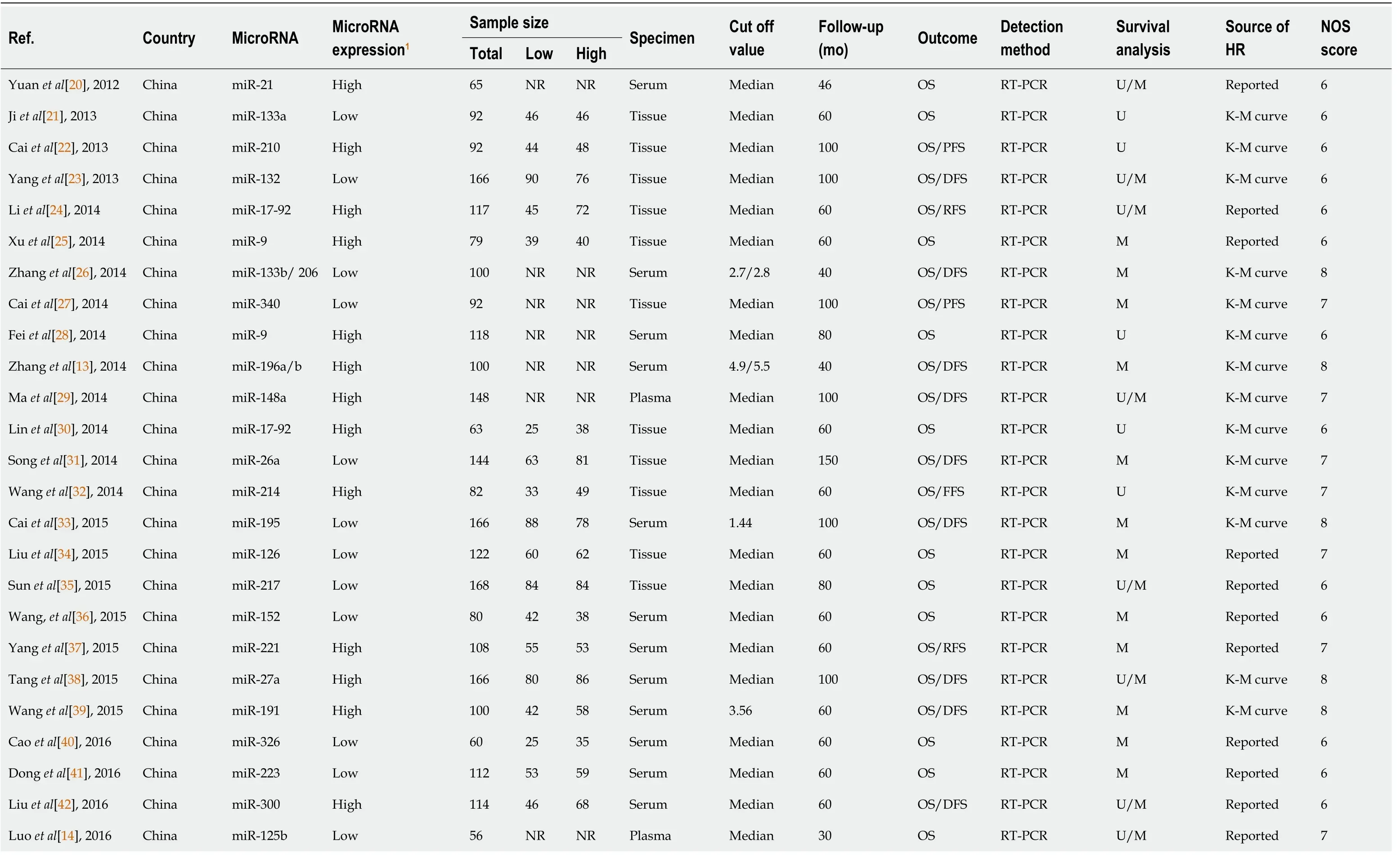
Table 1 Characteristics of eligible studies in this meta-analysis
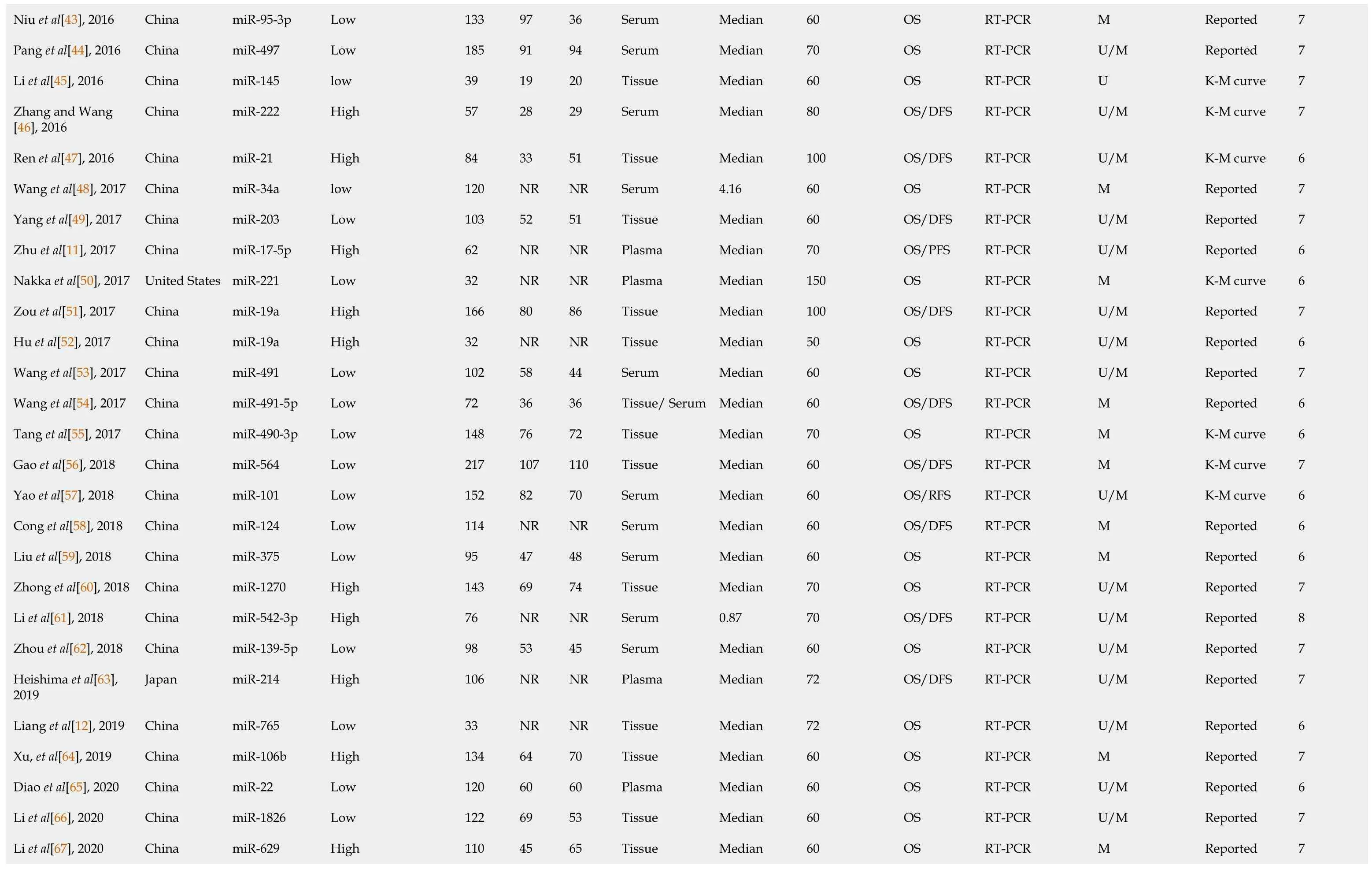
Niu et al[43], 2016 China miR-95-3p Low 133 97 36 Serum Median 60 OS RT-PCR M Reported 7 Pang et al[44], 2016 China miR-497 Low 185 91 94 Serum Median 70 OS RT-PCR U/M Reported 7 Li et al[45], 2016 China miR-145 low 39 19 20 Tissue Median 60 OS RT-PCR U K-M curve 7 Zhang and W ang[46], 2016 China miR-222 High 57 28 29 Serum Median 80 OS/DFS RT-PCR U/M K-M curve 7 Ren et al[47], 2016 China miR-21 High 84 33 51 Tissue Median 100 OS/DFS RT-PCR U/M K-M curve 6 Wang et al[48], 2017 China miR-34a low 120 NR NR Serum 4.16 60 OS RT-PCR M Reported 7 Yang et al[49], 2017 China miR-203 Low 103 52 51 Tissue Median 60 OS/DFS RT-PCR U/M Reported 7 Zhu et al[11], 2017 China miR-17-5p High 62 NR NR Plasma Median 70 OS/PFS RT-PCR U/M Reported 6 Nakka et al[50], 2017 United States miR-221 Low 32 NR NR Plasma Median 150 OS RT-PCR M K-M curve 6 Zou et al[51], 2017 China miR-19a High 166 80 86 Tissue Median 100 OS/DFS RT-PCR U/M Reported 7 Hu et al[52], 2017 China miR-19a High 32 NR NR Tissue Median 50 OS RT-PCR U/M Reported 6 Wang et al[53], 2017 China miR-491 Low 102 58 44 Serum Median 60 OS RT-PCR U/M Reported 7 Wang et al[54], 2017 China miR-491-5p Low 72 36 36 Tissue/ Serum Median 60 OS/DFS RT-PCR M Reported 6 Tang et al[55], 2017 China miR-490-3p Low 148 76 72 Tissue Median 70 OS RT-PCR M K-M curve 6 Gao et al[56], 2018 China miR-564 Low 217 107 110 Tissue Median 60 OS/DFS RT-PCR M K-M curve 7 Yao et al[57], 2018 China miR-101 Low 152 82 70 Serum Median 60 OS/RFS RT-PCR U/M K-M curve 6 Cong et al[58], 2018 China miR-124 Low 114 NR NR Serum Median 60 OS/DFS RT-PCR M Reported 6 Liu et al[59], 2018 China miR-375 Low 95 47 48 Serum Median 60 OS RT-PCR M Reported 6 Zhong et al[60], 2018 China miR-1270 High 143 69 74 Tissue Median 70 OS RT-PCR U/M Reported 7 Li et al[61], 2018 China miR-542-3p High 76 NR NR Serum 0.87 70 OS/DFS RT-PCR U/M Reported 8 Zhou et al[62], 2018 China miR-139-5p Low 98 53 45 Serum Median 60 OS RT-PCR U/M Reported 7 Heishima et al[63], 2019 Japan miR-214 High 106 NR NR Plasma Median 72 OS/DFS RT-PCR U/M Reported 7 Liang et al[12], 2019 China miR-765 Low 33 NR NR Tissue Median 72 OS RT-PCR U/M Reported 6 Xu, et al[64], 2019 China miR-106b High 134 64 70 Tissue Median 60 OS RT-PCR M Reported 7 Diao et al[65], 2020 China miR-22 Low 120 60 60 Plasma Median 60 OS RT-PCR U/M Reported 6 Li et al[66], 2020 China miR-1826 Low 122 69 53 Tissue Median 60 OS RT-PCR U/M Reported 7 Li et al[67], 2020 China miR-629 High 110 45 65 Tissue Median 60 OS RT-PCR M Reported 7

1MicroRNA expression with poor prognosis.High: High expression; Low: Low expression; OS: Overall survival; PFS: Progression-free survival; DFS: Disease-free survival; RFS: Recurrence-free survival; NR: Not reported; M: Multivariate analysis; U: Univariate analysis; NOS: Newcastle-Ottawa scale; RT-PCR: Real-time reverse transcription-PCR.
Meta-analysis in clinical outcome of osteosarcoma
This meta-analysis was conducted based on the survival endpoint used by each study.There were 60 studies evaluated OS of osteosarcoma, the pooled HR for OS was 2.92 (95%CI: 2.43-3.41,P= 0.000).For the 25 studies that evaluated DFS of patients, the pooled HR was 3.70 (95%CI: 2.80-4.61,P= 0.000).For the studies that tested PFS (n= 4) and RFS (n= 2) as their outcome assessments, the pooled HR were 3.57 (95%CI: 1.60-5.54,P= 0.000) and 3.71 (95%CI: 0.09-7.51,P= 0.056), respectively.The pooled HR of OS studies as well as that of DFS and PFS (P< 0.05) were found to be statistically significant; however, the effect of RFS studies did not reach the level of statistical significance.The forest plots of OS are presented in Figure 2A, and the forest plots of DFS, PFS and RFS are presented in Figure 2B.
Prognostic value of miR-21 in osteosarcoma
In our meta-analysis, there were three studies that assessed miR-21 as a predictor of OS in osteosarcoma.W e calculated the pooled HRs for these studies by using the random-effects model.The results suggested that high expression levels of miR-21 are correlated with poor OS (HR = 2.86, 95%CI: 1.20-4.53,P= 0.001).In addition, there was only one study that accessed the correlation between miR-21 expression and DFS, which indicates that the high expression levels of miR-21 are correlated with poor DFS.Therefore, miR-21 may be used as a biomarker of poor prognosis in osteosarcoma.
Subgroup analyses
As shown in Table 3, six subgroup analyses of OS in osteosarcoma patients were done depending on miRNA expression, specimen, survival analysis, source of HR, followup, and country of publication.To analyze the prognostic value of miRNA expression in osteosarcoma, we assessed the subgroups for high expression and low expression levels of miRNA for OS.The high expression levels of miRNA showed a pooled HR of 3.56 (95%CI: 2.59-4.54,P= 0.000), while the low expression levels of miRNA showed a pooled HR of 2.23 (95%CI:1.74-2.72,P= 0.000) (Figure 3A).The results were found to be statistically significant for both high expression and low expression levels of miRNA; however, the high expression levels of miRNA were significantly correlated with poor prognosis in osteosarcoma.The pooled HR of different specimen of miRNAs are as follows: tissue, 3.20 (95%CI: 2.16-4.23,P= 0.000); serum, 3.04 (95%CI: 2.37-3.71,P= 0.000); plasma, 0.94 (95%CI: 0.36-1.51,P= 0.001) (Figure 3B).The result show that pooled HR for univariate analysis was 2.36 (95%CI: 1.67-3.04,P= 0.000) and for multivariate analysis was 3.29 (95%CI: 2.52-4.07,P= 0.000), and the pooled HR for univariate analysis and multivariate analysis was 2.73 (95%CI: 1.95-3.50,P= 0.000) (Figure 3C).As shown in Figure 3D, the pooled HR calculated directly from the original reported studies was 3.00 (95%CI: 2.21-3.79,P= 0.000), and the pooled HR calculated from K-M curve was 2.48 (95%CI: 1.92-3.04,P= 0.000).In addition, we found that miRNAs contributed to a different OS when the follow-up time for patients was different, the pooled HR for less than 5 years of follow-up time was 3.08 (95%CI: 2.44-3.71,P= 0.000), and the pooled HR for more than 5 years of follow-up time was 2.75 (95%CI: 1.88-3.63,P= 0.000) (Figure 3E).Furthermore, the pooled HR for OS was 3.05 in China (95%CI: 2.52-3.57,P= 0.000) (Figure 3F).
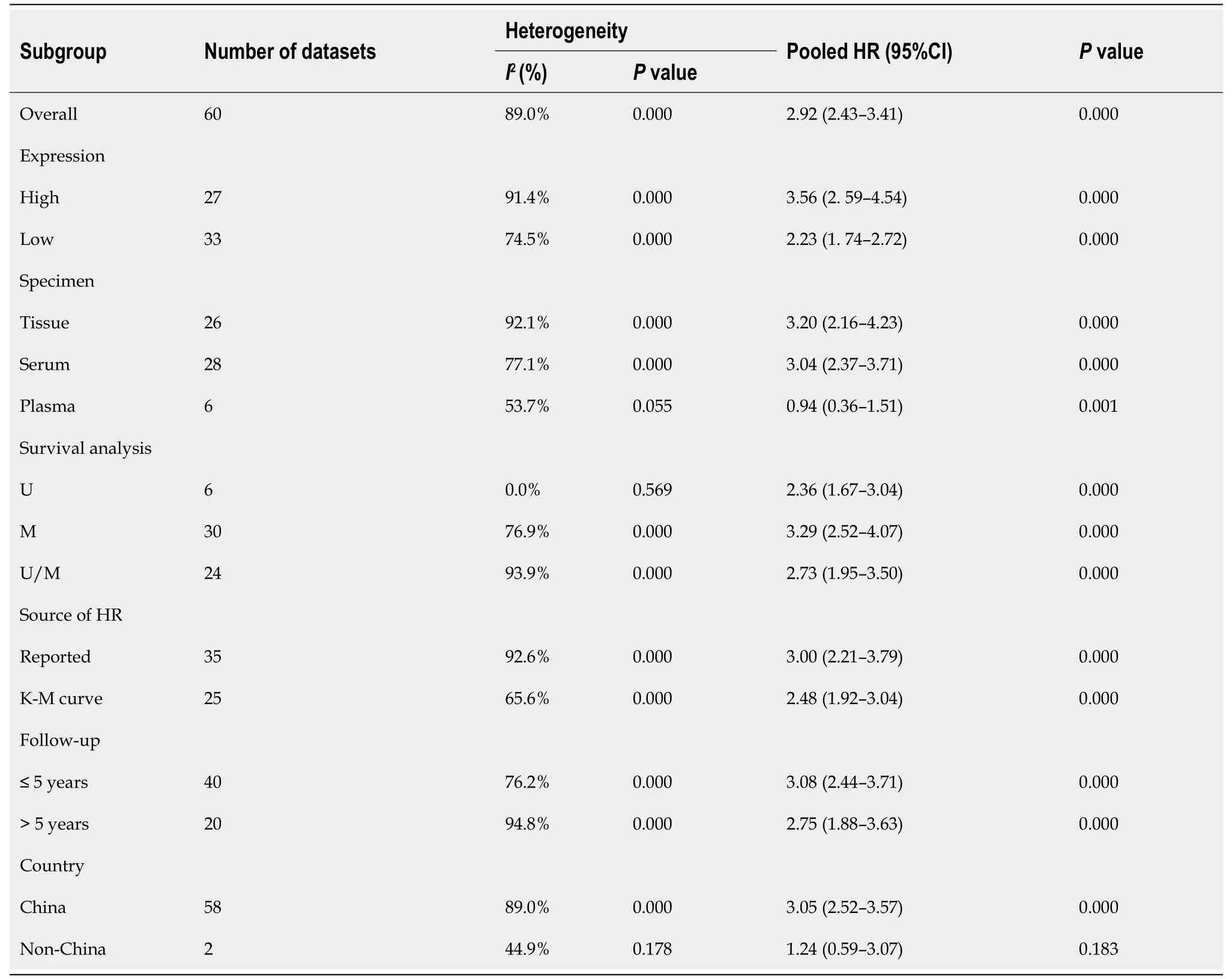
Table 3 Subgroup analyses of the relationship between microRNA expression and overall survival.

HR: Hazard ratio; CI: Confidence interval; OS: Overall survival; PFS: Progression-free survival; DFS: Disease-free survival; RFS: Recurrence-free survival.
Sensitivity analysis and publication bias
We conducted a sensitivity analysis using pooled HR and by omitting single studies, and none of these studies exceeded the outliers, which indicates that the pooled results of this meta-analysis are credible.The publication bias of included studies was assessed using Egger’s graphical tests, and thePvalues of Egger’s tests were 0.987, which indicates that there was no publication bias in our meta-analysis (Figure 4).

Figure 1 The flow chart of this meta-analysis to identify inclusion studies.
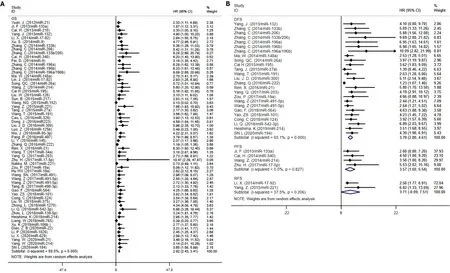
Figure 2 Forest plots for the microRNAs associated with clinical outcome.A: Forest plots for the microRNA (miRNA) associated with overall survival; B: Forest plots for the miRNAs associated with disease-free survival, progression-free survival and recurrence-free survival.

Figure 3 Forest plot of subgroup analysis.A: Subgroup analysis based on microRNA expression; B: Subgroup analysis based on specimen type; C: Subgroup analysis based on survival analysis; D: Subgroup analysis based on source of hazard ratio; E: Subgroup analysis based on follow-up; F: Subgroup analysis based on country of publication.
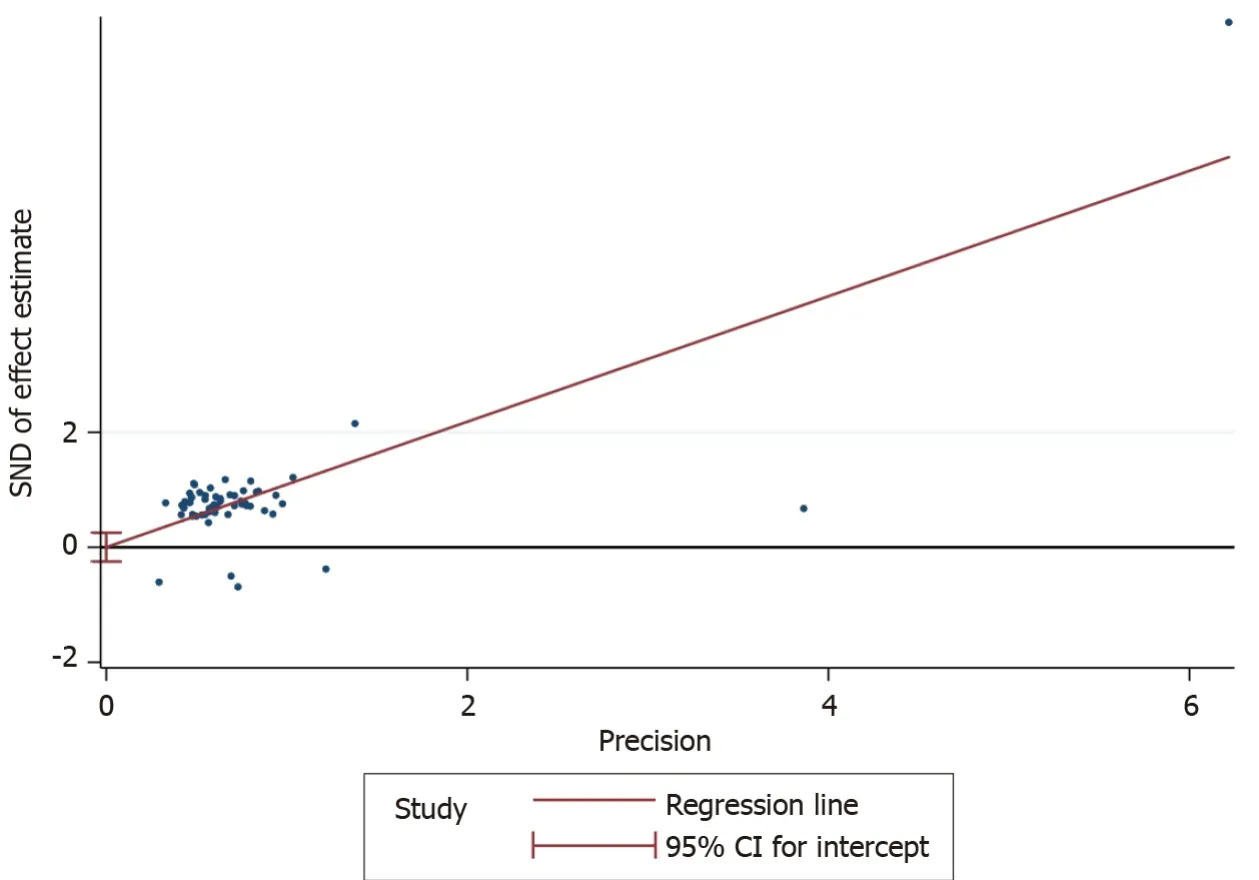
Figure 4 Egger’s test of publication bias.
DISCUSSION
Osteosarcoma is a malignant bone tumor occurring in teenagers.It is a mesenchymal tumor with histological features such as the presence of malignant mesenchymal cells and the production of bone stroma[70].As one of the most destructive malignant tumors, osteosarcoma has a 5-year survival rate of less than 60% due to its high aggressiveness and the tendency to metastasize early[71].It is well known that the key to the successful treatment of osteosarcoma is its accurate and timely diagnosis, and is also an important guarantee for improving prognosis and survival.This motivated us to explore more effective and/or more accurate biological biomarkers for clinical applications of osteosarcoma.MiRNAs have been used as biomarkers for the diagnosis, metastasis, and prognosis of many cancers.A large number of studies have reported the prognostic value of miRNA for osteosarcoma.However, the results are still controversial and no consensus has been reached.Therefore, we performed this meta-analysis to explore the prognostic function of miRNA in patients with osteosarcoma.
We collected all the literature on the prognostic value of miRNAs in osteosarcoma.First, we calculated the pooled HR according to the survival endpoint used in each study: the pooled HR for overall OS was 2.92 (95%CI: 2.43-3.41,P= 0.000), for DFS was 3.70 (95%CI: 2.80-4.61,P= 0.000), for PFS was 3.57 (95%CI: 1.60-5.54,P= 0.000), and for RFS was 3.71 (95%CI: 0.09-7.51,P= 0.056).It was found that the pooled HR were statistically related to the clinical outcome (OS, DFS, and PFS) of osteosarcoma (P< 0.05), but the impact of RFS did not reach a statistically significant level.We also evaluated the prognostic value of miR-21 in osteosarcoma.The result showed that high expression levels of miR-21 were associated with poor OS in osteosarcoma (HR = 2.86, 95%CI: 1.20-4.53,P= 0.001), which may be used as a marker of poor prognosis in patients with osteosarcoma.MiR-21 has been demonstrated to be a tumor oncogene and plays an important role in the progression of various types of tumors[72].A recent study suggested that, LncRNA neuroblastoma-associated transcript 1 suppresses the expression of miR-21 and also targets the miR-21-associated genes in osteosarcoma[73].MiR-21 modulates cell invasion and migration by directly targeting reversioninducing-cysteine-rich protein with kazal motifs and phosphatase and tensin homologue gene in osteosarcoma[74,75], it is also reduces the anti-tumor effect of cisplatin in osteosarcoma by regulating Bcl-2 expression[76].
Subsequently, due to heterogeneity of studies, we conducted a subgroup analysis of OS in patients with osteosarcoma on the basis of miRNA expression, specimens, survival rate analysis, HR source, follow-up status, and publishing country.The high expression level of miRNA shows that the combined HR is 3.56 (95%CI: 2.59-4.54,P= 0.000), while the low expression level of miRNA shows that the combined HR is 2.23 (95%CI: 1.74-2.72,P= 0.000).This indicates that the altered miRNA is related to the poor prognosis of osteosarcoma, and the high expression level of miRNA indicates a higher risk of poor prognosis of osteosarcoma.Different miRNA specimen sources may lead to different clinical outcomes.We found that miRNA from tissues (HR: 3.20, 95%CI: 2.16-4.23,P= 0.000) may be a stronger prognostic biomarker for patients with osteosarcoma.As regards the source of HR, there is no big difference between the HR directly reported in the original article and the HR extracted in the K-M survival curve, which indicates that the data extracted from the K-M survival curve according to the previous methods were reliable[17].The length of follow-up time has different prognosis in osteosarcoma, and we found that patients with less than 5 years of follow-up have a higher risk of poor prognosis than those with more than 5 years of follow-up.This may be related to tumor aggressiveness and metastasis of osteosarcoma.The survival time of orthotopic osteosarcoma is significantly longer than that of patients with metastasis[71].Moreover, the country of publication has no significant impact on the prognosis of patients with osteosarcoma.Finally, we conducted sensitivity analysis and publication bias and found that the combined results of the study are credible without publication bias.
This is a comprehensive meta-analysis to evaluate the prognostic function of miRNAs for osteosarcoma.Two investigators independently conducted literature screening and data extraction based on strict inclusion and exclusion criteria.We make every effort to avoid publishing biases, but we acknowledge that this meta-analysis still has some limitations.First, we excluded a small number of studies that lacked original data or could not calculate HR, which may relatively reduce the convincing power of the results.Secondly, some HR data are extracted from the survival curve, which may bring small errors.Future research should be based on data obtained directly from the original article if possible.Third, although there is no obvious publication bias in this meta-analysis, positive results are more likely to be published than negative results, which may lead to an overestimation of the association between miRNAs and poor prognosis of osteosarcoma.Fourth, almost all of the 54 articles included are from China, except for one from the United States and one from Japan.Therefore, the applicability of miRNA as a prognostic indicator of osteosarcoma in other countries and regions is unclear, and our results need to be proved by more studies from other regions.
CONCLUSION
In summary, miRNA (especially miR-21), could be used as a potential prognostic biomarker for osteosarcoma.A high expression level of miRNA in tumor tissue correlated with worse OS of osteosarcoma.However, we should also focus on the low expression level of several special miRNAs.Furthermore, a large number of samples, particularly multi-center, multi-country prospective studies, will be required in the future to enhance the persuasiveness of the prognostic role of miRNA in osteosarcoma.
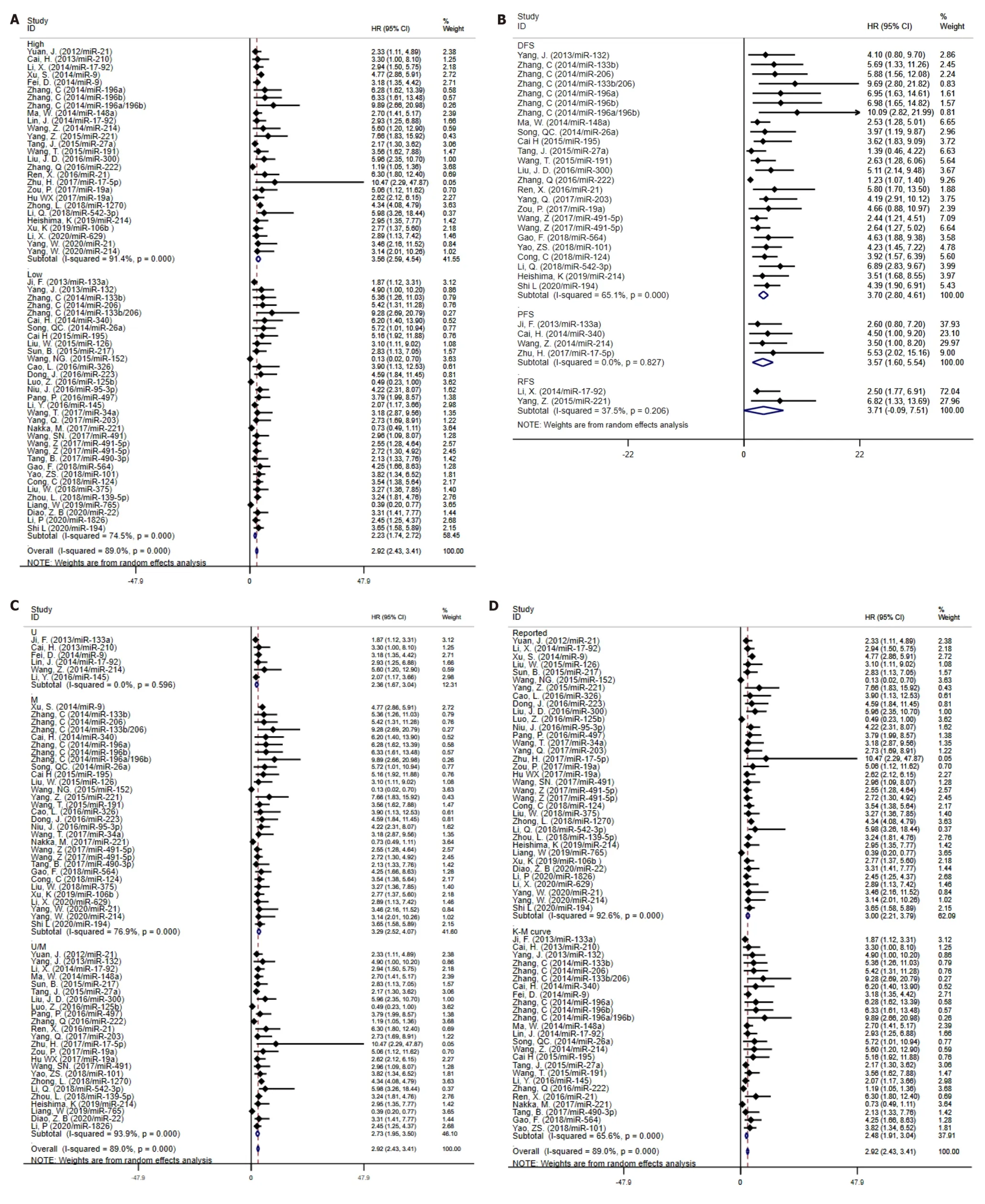
ARTICLE HIGHLIGHTS
Research background
Osteosarcoma is one of the most common primary malignant bone tumors in children, with rapid progress and poor prognosis.microRNA (miRNA) has been proposed as a valuable biomarker for the prognosis of osteosarcoma, but the results are not consistent.
Research motivation
We wished to gain a detailed insight into the effect of circulating miRNA on the prognosis of patients with osteosarcoma.
Research objectives
The aim of this meta-analysis was to study the prognostic value of miRNA expression in patients with osteosarcoma.
Research methods
A literature search was conducted to identify studies published through July 1, 2021.Random-effects meta-analyses were conducted for combinations of the outcomes of overall survival (OS), disease-free survival (DFS), progression-free survival (PFS), and recurrence-free survival in osteosarcoma patients.Subgroup analyses were conducted to identify sources of heterogeneity.Publication bias was assessed by Egger’s bias indicator test.
Research results
A total of 60 studies were included for this meta-analysis.The pooled HR for OS, DFS, PFS were 2.92 (95%CI: 2.43-3.41,P= 0.000), 3.70 (95%CI: 2.80-4.61,P= 0.000), and 3.57 (95%CI: 1.60-5.54,P= 0.000), respectively.The high expression levels of miR-21 were associated with poor OS in osteosarcoma (HR = 2.86, 95%CI: 1.20-4.53,P= 0.001).
Research conclusions
Circulating miRNA could be used as a potential prognostic biomarker for osteosarcoma.
Research perspectives
Evidence from later studies could consolidate these conclusions.A large number of samples prospective studies are needed in the future to enhance the persuasiveness of our conclusion.
 World Journal of Meta-Analysis2021年6期
World Journal of Meta-Analysis2021年6期
- World Journal of Meta-Analysis的其它文章
- Efficacy and safety of fingolimod in stroke: A systemic review and meta-analysis
- Hydroxychloroquine alone or in combination with azithromycin and corrected QT prolongation in COVID-19 patients: A systematic review
- Prediabetes and cardiovascular complications study: Highlights on gestational diabetes, self-management and primary health care
- Newer developments in viral hepatitis: Looking beyond hepatotropic viruses
- Gastrointestinal tumors and infectious agents: A wide field to explore
- Preclinical safety, effectiveness evaluation, and screening of functional bacteria for fecal microbiota transplantation based on germ-free animals
